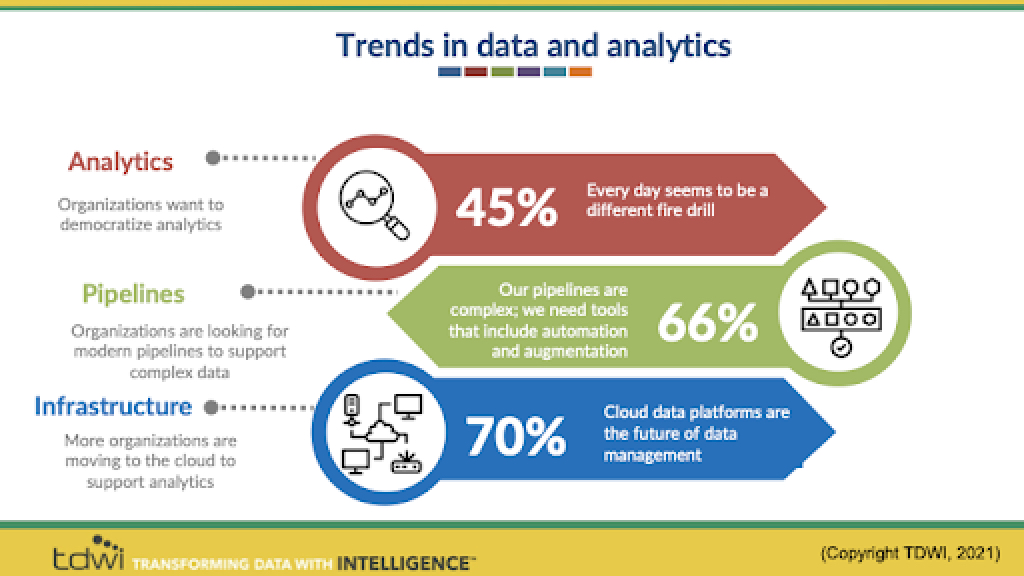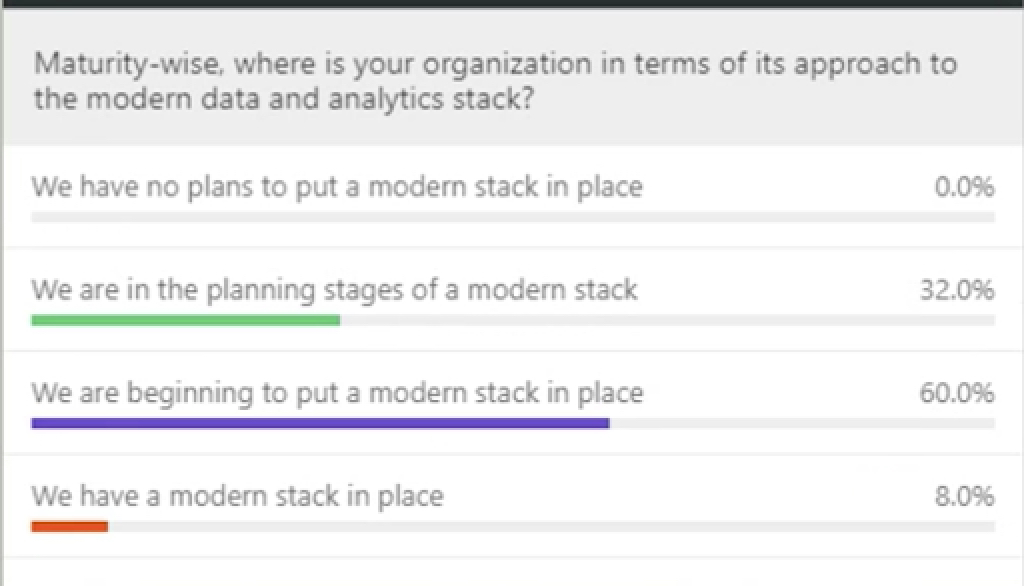In a recent webinar by TDWI, 45% of analysts reported that “every day seems to be a different fire drill.” No surprise to anyone in the industry.

As much as analysts need to be focused on more strategic tasks, their skills are frequently deployed to answer basic questions. Greater self-service capabilities for end-users would no doubt alleviate these fire drills, but this is not yet a reality for the majority of companies. Take for instance the fact that self-service analytics (the blue bar in the graphic below) has ranked as the biggest priority — ahead of automation or ever-popular machine learning — for the last three years in a row.

TDWI hypothesizes that it’s not a lack of motive or understanding that’s hindering companies from achieving their self-service analytics goals. Rather it’s not having the best possible foundation. An in-webinar poll revealed that only 8% of the audience had the full capabilities of a modern data and analytics stack in place today, while the overwhelming majority of respondents were just starting their journey.

Helpfully, TDWI put together a comprehensive research report on the six critical requirements for a modern data and analytics cloud stack, and panelists from industry-leading data and analytics companies like Snowflake and Fivetran also weighed in. Read on for some of the top takeaways from the conversation.
What are the most critical components to building a modern data and analytics stack?
“Intelligent infrastructure”, fully automated management of data” — Jena Donlin, Sr Product Marketing Manager, Snowflake
“Query data where it is and...new uses can be stood up overnight.” — Lisa Aguilar, Director, Product Marketing, ThoughtSpot
“Has to be automated and has to be cloud-based. All about removing the requirement for data teams having to go in and managing the ins and outs of the data pipeline.” — Dayna Shoemaker, Sr Product Marketer, Fivetran
What are the biggest challenges for organizations?
“Legacy pipelines lead to legacy data. Legacy data leads to legacy insights.” — Lisa Aguilar, Director, Product Marketing, ThoughtSpot
What should organizations do about vendor lock-in?
“Consider using Open Source tools when and where applicable.” — Dayna Shoemaker, Sr Product Marketer, Fivetran
“Think about data portability...being able to move data across different cloud providers is becoming both a business need and, especially in Europe, a requirement.” — Jena Donlin, Sr Product Marketing Manager, Snowflake
What about tools that have already been invested in?
“Tackle cloud-only or cloud-specific use cases first.” — Jena Donlin, Sr Product Marketing Manager, Snowflake
“Don’t just move, improve. No need to upgrade tools if you don’t have tangible outcomes outlined.” — Lisa Aguilar, Director, Product Marketing, ThoughtSpot
“Don’t think of the question as ‘how do I replace?’ but rather ‘what am I solving for?” — [Lisa Aguilar, Director, Product Marketing, ThoughtSpot
What are best practices for governance and security?
“Know your data, control your data and unify and simply with centralized controls across all your workloads.” — Jena Donlin, Sr Product Marketing Manager, Snowflake
“For BI tools, be sure that security protocols are carried over from their original source.” Lisa Aguilar, Director, Product Marketing, ThoughtSpot








